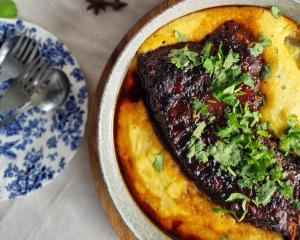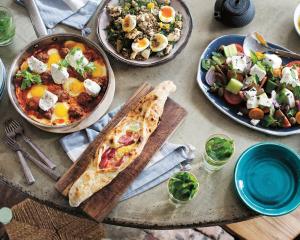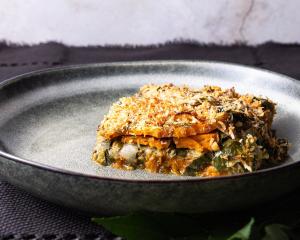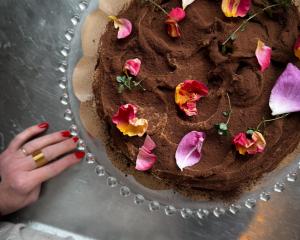
A simple request from her daughter planted the seed in Sai Yoganathan’s mind about writing a cookbook.
‘‘My daughter left home after university and said she can’t cook without a recipe, so ‘you need to compile your recipes into a cookbook’.’’

‘‘I never dreamed I could get a publisher.’’
Back then, Yoganathan, an accountant who moved to New Zealand in 1993 from Sri Lanka via Nigeria, was working at the Southern District Health Board in Dunedin.
In her spare time, when she was not teaching classical Indian dancing, she began to research writing a cookbook, talking to publishers and publicists to get advice.
But when her daughter Varayini settled in Sydney, Yoganathan decided to move to Australia to help her.
‘‘I thought I could finish the book and help my daughter.’’
Continuing to compile recipes, Yoganathan began taking photos of dishes she was cooking, including traditional curries and desserts handed down to her by her mother Jeeva.
‘‘[They were] the dishes we enjoyed growing up, [including] my grandmother’s lamb curry, of course.’’
Her own recipes are influenced by her Sri Lankan background and her time spent living in Africa and New Zealand.
‘‘I love to spend time in the kitchen.’’
Ingredients have to be the freshest and best quality she can find and she is an advocate for farmers markets, saying ‘‘produce down under just tastes better’’.
She describes many of the recipes in her book as ‘‘fusion’’, such as her New Zealand groper and cauliflower puree with roast tomatoes and pakoda.
‘‘It’s a lovely fusion dish using my mum’s mango chutney and lentil pakoda. I miss the groper [now that I live] in Sydney.’’
Worried she would get type two diabetes like her mother, Yoganathan began to look at more healthy options for the everyday meals she cooks.
‘‘I experimented with ingredients, using less carbohydrates, more protein and incorporating my flavours.’’
During the week, she keeps meals simple with dishes such as steak with a cauliflower puree and picked vegetables, grilled fish or chicken with harissa and a couscous or quinoa salad.
‘‘Weekends are for indulging in rice and curry.’’
The family eats vegetarian on a Saturday night for religious reasons. Yoganathan cooks vegetarian curries with lentils and a spicy gravy and on Sunday it is usually a beef curry as she misses the quality and flavour of New Zealand lamb.
‘‘There are a lot of things I miss from New Zealand. I look forward to coming back to New Zealand, it’s home. I love the people, the food and Dunedin’s farmers markets and the big fat cherries.’’
But she makes exceptions to the healthier approach for her dinner parties.
‘‘It’s an excuse to make dessert and enjoy it.’’
Yoganathan has always liked to experiment with her desserts.
Her favourite is her cardamom pana cotta with raspberry rose jelly served in a glass.
‘‘The rose water adds the best flavour. I like to put rose in everything.’’
Another recipe she had fun developing was her deconstructed raspberry and white chocolate cheesecake with lychee sorbet.
‘‘It’s not heavy. I was very proud of creating that. I served it at a dinner party and everyone loved it.’’
The enjoyment is in seeing those she loves enjoying her food, how it tastes and looks, she says.
‘‘How it all comes together in this magical recipe. It’s very satisfying seeing everyone satisfied.’’
Her passion for cooking began, as it does for many, at her mother’s apron. She credits her mother for giving her the courage to explore different ingredients and flavours.
‘‘I started when I was very young following my mother. I used to be a pest but she was very patient. She’d give me some cake batter to bake my own cake. She showed me how she was cooking. We were allowed in the kitchen to help out.’’
And she has never stopped.
‘‘I come from a family of food lovers, my auntie, my grandma and everything. That helped me to do more cooking and enjoy cooking.’’
Even today she still cooks for her children. Sunday is her food preparation day when she cooks different combinations of curries and packages it up for her daughter’s lunch.
‘‘It keeps me going. I like to be useful. I enjoy making it.’’
Always keen to do charity work, Yoganathan decided she wanted the royalties from her cookbook to go towards a ‘‘purpose’’, so she dedicated the book to her father, Rajnedram, who died of a brain tumour. The royalties are going to the New Zealand Brain Tumour Trust.
‘‘My Dad could still be living if there had been better research. Hopefully, we can raise as much as we can through the book sales.’’
 Photos: Supplied
Panko crusted fish and spicy miso
Photos: Supplied
Panko crusted fish and spicy miso

I love the mellow, salty, savoury taste of miso. Thanks go to my daughter, who introduced me to this low calorie ingredient with plenty of adaptability. This dish is a powerful display of Asian flavours.
Serves 4
Prep 30 minutes
Cook 60 minutes
Ingredients
700–750g snapper fillets (4 pieces), skin on
2 packets good-quality instant miso soup
4 spring onions, white and green parts separated
5cm piece ginger, grated
1–2 red chillies, finely chopped
8 basil leaves, rolled and sliced very thinly
6 Tbsp peanut oil
4 medium courgettes, sliced
1 Tbsp butter
1 cup panko crumbs
3 cups chicken stock, salt to taste
1–2 tsp sugar or natural sweetener
juice of 1 lime, plus extra wedges for serving
Method
1. Heat the oven to 200degC. Slice the green part of the spring onions into fine rings. Slice the white part into julienne strips for garnishing.
2. Place the grated ginger and sliced green spring onions in a heatproof bowl. In another heatproof bowl, combine the red chilli and finely sliced basil leaves.
3. Heat the peanut oil in a frying pan until smoking hot. Pour half of the heated oil into the ginger and spring onion mixture and the other half into the chilli mixture. Set aside until required.
4. In a separate pan, saute the courgettes in the butter. Divide equally among four serving plates and keep warm.
5. Brush the fish pieces with oil and sprinkle with salt. Using the same pan, sear the fish skin side down for one minute. Turn and cook the other side for another minute. Brush the fish with the ginger and spring onion oil mixture, sprinkle with panko crumbs, and grill in the preheated oven for 6-8 minutes.
6. While the fish is in the oven, bring the chicken stock to a boil, then remove from the heat. Mix miso soup packet contents and sugar in the hot stock and whisk to combine.
To serve
7. Carefully ladle the hot miso broth on to the plate. Place the grilled fish and courgettes on top and garnish with julienned spring onions and lime wedges. Add lime juice to the chilli and basil oil and drizzle it around the fish.
Note: I use 10g packets of Mitoku instant miso soup (white with tofu) in this recipe.
If you are unable to find instant miso soup, replace it with the same measure of white miso paste.
 Szechuan duck legs with coconut milk rice and pickled ginger
Szechuan duck legs with coconut milk rice and pickled ginger

This duck recipe has loads of contrasting textures and character. Rich duck meat is complemented by a warming sauce laced with ginger, red chillies, garlic and lemony Szechuan pepper. Mung dal adds flavour and bite to the milky, coconut rice.
Serves 2
Prep 30 minutes
Cook 60 minutes
Ingredients
For the duck
2 duck legs
1 red chilli, finely sliced
½ red onion, sliced
3 cloves garlic, finely chopped
2 tsp ginger, grated salt to taste
1 orange
1½ Tbsp soy sauce
¼ cup water
2 Tbsp honey
1 tsp vegetable oil
For the garnish
1 red chilli, sliced 4–6 chives
1–2 courgettes, cut into ribbons
For the spice rub
1 tsp Szechuan pepper
¼ of a star anise
¼ of a whole mace 1 tsp coriander seeds
½ tsp cumin seeds
½ tsp fennel seeds 3cm cinnamon quill
For the coconut rice
1 cup basmati rice
1½ Tbsp mung dal (skinned and split), toasted
1¾ cups water
¼ cup thick coconut milk a pinch of salt
Method
1. Heat the oven to 180degC.
2. Prepare the spice rub by lightly toasting all the spices for 2-3 minutes over a low heat until aromatic. Using a spice grinder, process into a coarse powder and set aside.
3. Place a deep frying pan over a medium heat. Rub the duck legs with salt and brown on each side for 3 minutes. Remove from the heat and transfer into an baking dish. Massage the ground spice all over the skin of the duck.
4. In a clean frying pan, heat the oil and saute the ginger and garlic for 30 seconds. Add the chilli and onion, and cook for 2-3 minutes.
5. Mix the orange juice with the soy sauce and water. Stir and pour over the duck, then drizzle with honey. Cover with tin foil and bake in the oven for 35-40 minutes. Remove the foil, cook for a further 10 minutes until the duck is cooked through and tender.
6. While the duck is in the oven, prepare the coconut rice. Rinse the rice and place in a saucepan with water and salt. Bring to a boil and cook over a medium heat for 10 minutes.
7. Stir in the toasted mung dal and coconut milk and cook for a further 5 minutes with the lid on. Remove from the heat and keep warm until required.
8. Serve the duck legs with coconut rice, garnished with chives, red chilli and courgette ribbons.
 Apricots three ways with creme anglaise and almond cake
Apricots three ways with creme anglaise and almond cake

This stunning dessert celebrates the arrival of golden, ripe apricots from the orchards of Central Otago. Sweet and creamy vanilla-infused custard beautifully balances the acidity of the fruit. The refreshing sorbet is spiced up with green chilli and ginger. A perfect summer treat.
Serves 8
Prep 60 minutes
Cook/freeze 30 minutes
Ingredients
For the apricot sorbet
500g apricots, cut into quarters, stones removed
45ml water, plus 125ml water
150g sugar
2 Tbsp liquid glucose
2cm piece fresh ginger, grated
½ tsp green chilli, finely chopped
For poached apricots and puree
275g apricots, sliced and stones removed
zest of ½ a lemon
110g caster sugar
2 Tbsp water
1 vanilla pod, split
For almond cake
100g butter, softened
100g sugar
2 eggs
50g flour
50g ground almonds
1 tsp baking powder
1 tsp almond extract
75g slivered almonds
Method
To make the sorbet
1. Place 45ml water, the sugar and liquid glucose in a saucepan and bring to a boil. Heat through for 5 minutes until the sugar is dissolved. Remove from the heat and set aside to cool down completely.
2. In a food processor, puree the apricot quarters with the ginger and 125ml water. Transfer to a large bowl with the green chilli. Whisk in the sugar syrup. Churn in an ice cream maker and transfer to a freezer-proof container and freeze overnight.
To poach the apricots
1. Place the lemon zest, sugar, water and scraped vanilla seeds with the vanilla pod into a saucepan. Bring to the boil and stir occasionally until the sugar dissolves.
2. Add the apricot slices to the hot syrup and cook for 1 minute. Remove from the heat and set aside.
To make the apricot puree
1. Place half of the poached apricots in a blender. Blend to a puree. Keep refrigerated until required. Set the other half of the poached apricots aside until ready to serve the dessert.
To make the almond cakes
1. Heat the oven to 180degC. Place eight cupcake cases (7cm diameter, 2.5cm height) on a baking tray.
2. Beat the butter and sugar together in a bowl until the mixture is light and fluffy. Add the eggs, beating well after each addition.
3. In a separate bowl, mix the flour, ground almonds and baking powder. Fold into the creamed butter mixture with the almond extract. Stir to combine.
4. Spoon the mixture equally into the cupcake cases. Scatter the slivered almonds on top and bake for 15-20 minutes, or until the cakes are golden. Drizzle a little of the liquid from the remaining poached apricots over the warm cakes. Set aside.
5. Serve the almond cake with a quenelle of apricot sorbet, creme anglaise (see below), the rest of the poached apricot slices and the apricot puree.
Creme anglaise
Ingredients
2 egg yolks
50g sugar
375ml fresh cream
1 vanilla pod, split
Method
1. Whisk together the egg yolks and sugar until pale and creamy.
2. In a saucepan, heat the cream with the vanilla pod and seeds until small bubbles appear around the edge. Gradually pour the hot cream over the egg mixture, whisking continuously.
3. Pour the creme anglaise back into the saucepan and gently heat for 2-3 minutes, or until it is thick enough to coat the back of a spoon.













